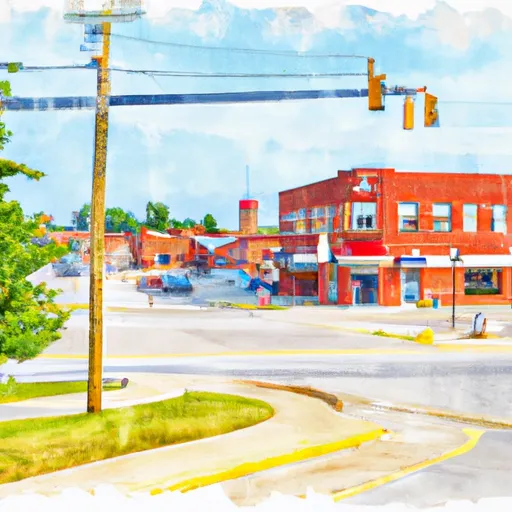-
 Snoflo Premium
Snoflo Premium
Get unlimited access to all our content
With no Ad interruptions! - Start Your Free Trial Login with existing account
Mancelona
Eden Index
Climate
6.0
•
Recreation
5.2
•
Community
2.0
•
Safeguard
4.7/10

Mancelona is a small town located in the northern part of Michigan's Lower Peninsula. It experiences a continental climate, characterized by warm summers and cold winters. Average temperatures range from around 20°F (-6°C) in winter to 80°F (27°C) in summer. The area receives a moderate amount of rainfall throughout the year, creating a suitable environment for hydrological activities.
Mancelona is surrounded by numerous lakes, rivers, and streams, making it an ideal destination for water-based recreation. The region offers opportunities for fishing, boating, kayaking, and swimming. The scenic Jordan River, known for its crystal-clear waters and excellent fishing, flows through the area, attracting outdoor enthusiasts.
Moreover, Mancelona is surrounded by beautiful forests that provide ample opportunities for hiking, camping, and wildlife viewing. The town is also home to several parks and trails, including the Mancelona Nature Preserve and the Glacial Hills Pathway and Natural Area, which offer picturesque landscapes and year-round recreational activities like mountain biking, cross-country skiing, and snowshoeing.
Overall, Mancelona, Michigan, with its pleasant climate, hydrological features, and diverse outdoor recreation opportunities, is a great destination for nature lovers and adventure seekers alike.
What is the Eden Index?
The Snoflo Eden Index serves as a comprehensive rating system for regions, evaluating their desirability through a holistic assessment of climate health, outdoor recreation opportunities, and natural disaster risk, acknowledging the profound impact of these factors on livability and well-being.
Climate Health Indicator (CHI): 6.0
Mancelona receives approximately
851mm of rain per year,
with humidity levels near 84%
and air temperatures averaging around
6°C.
Mancelona has a plant hardyness factor of
4, meaning
plants and agriculture in this region thrive during a short period during spring and early summer. Most
plants will die off during the colder winter months.
By considering the ideal temperature range, reliable water supplies, clean air, and stable seasonal rain or snowpacks, the Climate Health Indicator (CHI) underscores the significance of a healthy climate as the foundation for quality living.
A healthy climate is paramount for ensuring a high quality of life and livability in a region, fostering both physical well-being and environmental harmony. This can be characterized by ideal temperatures, reliable access to water supplies, clean air, and consistent seasonal rain or snowpacks.
Weather Forecast
Streamflow Conditions
Northeastern Lake Michigan
Area Rivers
Northeastern Lake Michigan
Snowpack Depths
Northeastern Lake Michigan
Reservoir Storage Capacity
Northeastern Lake Michigan
Groundwater Levels
Recreational Opportunity Index (ROI): 5.2
The Recreational Opportunity Index (ROI) recognizes the value of outdoor recreational options, such as parks, hiking trails, camping sites, and fishing spots, while acknowledging that climate plays a pivotal role in ensuring the comfort and consistency of these experiences.
Access to outdoor recreational opportunities, encompassing activities such as parks, hiking, camping, and fishing, is crucial for overall well-being, and the climate plays a pivotal role in enabling and enhancing these experiences, ensuring that individuals can engage in nature-based activities comfortably and consistently.
Camping Areas
| Campground | Campsites | Reservations | Toilets | Showers | Elevation |
|---|---|---|---|---|---|
| Tahquamenon Falls 1 State Park | 275 | 616 ft | |||
| Epoufette Township Park | 5 | 588 ft | |||
| Trout Lake City Park | 83 | 830 ft | |||
| Tahquamenon Falls 2 State Park | 90 | 752 ft | |||
| Shelldrake Dam - State Forest | 18 | 648 ft | |||
| Lake Michigan | 34 | 601 ft | |||
| Soldier Lake Rec Area | 43 | 908 ft | |||
| Brevort Lake | 84 | 632 ft | |||
| Andrus Lake - State Forest | 25 | 637 ft | |||
| Three Lakes | 28 | 877 ft |
Nearby Ski Areas
Catastrophe Safeguard Index (CSI):
The Catastrophe Safeguard Index (CSI) recognizes that natural disaster risk, encompassing floods, fires, hurricanes, and tornadoes, can drastically affect safety and the overall appeal of an area.
The level of natural disaster risk in a region significantly affects safety and the overall livability, with climate change amplifying these risks by potentially increasing the frequency and intensity of events like floods, fires, hurricanes, and tornadoes, thereby posing substantial challenges to community resilience and well-being.
Community Resilience Indicator (CRI): 2.0
The Community Resilience Indicator (CRI) recognizes that education, healthcare, and socioeconomics are crucial to the well-being of a region. The CRI acknowledges the profound impact of these elements on residents' overall quality of life. By evaluating educational resources, healthcare accessibility, and economic inclusivity, the index captures the essential aspects that contribute to a thriving community, fostering resident satisfaction, equity, and social cohesion.

